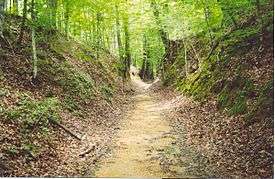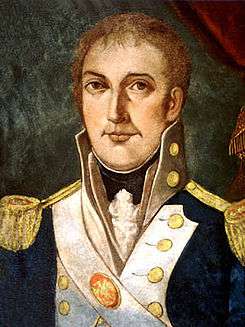Peter Alston
| Peter Alston | |
|---|---|
|
While, with his father, the notorious counterfeiter, Philip Alston, at the infamous, outlaw lair of Cave-in-Rock, Peter Alston, around 1797-1799, joined Samuel Mason and his gang of river pirates, on the Ohio River. | |
| Born |
after 1765 ? |
| Died |
February 8, 1804 Old Greenville, Jefferson County, Mississippi Territory, present-day Greenville, Jefferson County, Mississippi |
| Resting place |
unknown death_cause = execution by hanging |
| Nationality | American |
| Other names | James May, Samuel May, Isaac May |
| Occupation | river pirate, horse thief, burglar, highwayman, counterfeiter |
| Known for | Being the criminal associate of serial-killer, Wiley "Little" Harpe and his partner, in the murder of notorious outlaw gang leader, Samuel Mason. Alston was also, the son of the American 1770s counterfeiter, Philip Alston, who had connections to Cave-in-Rock, Russellville, Kentucky, and Natchez, Mississippi. |
| Parent(s) | Philip Alston, Temperance Smith, Mary Molly Temple, Mildred McCoy |
| Relatives | Solomon Alston (grandfather), Sarah Ann "Nancy" Hinton Alston (grandmother), John Alston (uncle), Philip Alston, Jr. (brother), John McCoy Alston (brother), Frances Alston (sister), Elizabeth Elise Alston (sister), James D. Dromgoole (brother-in-law), John Gilbert (brother-in-law) |
Peter Alston (after 1765 - February 8, 1804) was the late 18th Century and early 19th Century counterfeiter, horse thief, highwayman, and river pirate, who was believed to be the associate of serial-killer, Little Harpe and partner, in the murder of notorious outlaw, leader Samuel Mason in 1803. Alston was also, the son of the colonial-era counterfeiter, Philip Alston, associated with Cave-in-Rock, Illinois, and Natchez, Mississippi.[1]

Early life
Peter Alston was born, the son of the notorious counterfeiter, His mother was one of the three wives of his father; Temperance Smith, Mary Molly Temple, or Mildred McCoy. Alston had two brothers, Philip, Jr. and John McCoy and two sisters, Frances and Elizabeth Elise. His grandparents on the side of his father were Solomon Alston and Sarah Ann "Nancy" Hinton Alston. John Alston, the brother of his father, was also, a notorious counterfeiter. The Alston family had its origins in, the British Royal colony of, the Province of South Carolina, where the Alston surname was very common. the When and where he was born and where he grew up is not known, as there is scant information, on his childhood and pre-criminal activities. He may have been born in South Carolina, North Carolina, Virginia, Natchez, West Florida, now present-day Natchez, Mississippi, Fort Nashborough, Virginia, now present-day Nashville, Tennessee, or Russellville, Virginia, now present-day Russellville, Kentucky. Having been the son of an outlaw, Peter Alston probably moved where ever his father hastily moved their family, remaining as far away from the pursuit of the law. Even as an adult, No doubt, Peter Alson was not far from his father's criminal presence and influence.


Criminal activities
According to Alex C. Finley, in The History of Russellville and Logan County, Ky, Peter Alston used the alias "James May", as Wiley Little Harpe had used the name "John Setton", as his alias. At other times, Alston also, used the aliases, Samuel May and Isaac May.[2]
The earliest recorded use of the Peter Alston alias, James May, dated back to around 1797 or 1798, in Red Banks, Kentucky, now present-day Henderson, Henderson County, Kentucky, where Alston appeared, with a woman, who claimed to be his lame sister, which could have been, one of his two sisters, Francis or Elizabeth. While at the Red Banks, Alston stole horses, but was caught in Vincennes, Northwest territory, now present-day Vincennes, Indiana, and brought back for trial. Peter Alson was never tried, as he broke out of jail the first night he was incarcerated.[3]
Peter Alston later, shifted his operations down river to Stack Island, on the lower Mississippi River, along with Samuel Mason, the notorious outlaw gang leader, after regulators cleaned the frontier criminal element out of western Kentucky and Cave-in-Rock, Northwest territory, now present-day Cave-in-Rock, Illinois, in the summer of 1799. There Alston reunited with his father, Philip and cast counterfeit silver coins, as well as, taking part in Mason's river piracy operations.[4]
Arrest, escape, and execution
T. Marshall Smith, in his Legends of the War of Independence published in 1855, gives the earliest account so far identifying Peter Alston, as the second killer of Samuel Mason in 1803, as opposed to the name James May, which the killer used as an alias. Alexander Finley, in his History of Russellville and Logan County Kentucky published two decades later, he included a more detailed account of criminal activities of his father, Philip Alston and also, named Peter Alston, as the second killer of Mason.
Following his escape and a shootout, with his Spanish soldier, who were transporting him, in manacles, from New Orleans to Spanish West Florida, and turning him over to the American authorities in Natchez, Mississippi Territory, Samuel Mason received a serious gunshot wound, which may have been the true cause of his death and not murder, at the hands of Alston and Harpe, as presumed by most historians.
Peter Alston and Wiley Harpe, if they killed Mason, at all, with a tomahawk, in 1803, made a maximum effort in securing the large sum offered in a reward by Mississippi Territorial governor, William A. Claiborne for the outlaw's head. A day after turning in Mason's decapitated head, for the reward money, in Natchez, the real identities of James May and John Setton were discovered and the two men were arrested. Peter Alston and Wiley Harpe escaped, but were captured and tried for Mason's murder. Convicted and sentenced to death on February 4, 1804, the two outlaws were hanged four days later, on February 8, 1804. Once they were pronounced dead, their heads were cut off and placed on poles, along the Natchez Trace, as a warning to future river and land pirates.[5]
References
- ↑ T. Marshall Smith. 1855. Legends of the War of Independence, and of the Earlier Settlements in the West. Louisville, Ky.: J. F. Brennan, Publisher. 342-344. Online at www.archive.org.
- ↑ Alex C. Finley. 1876, Reprint c. 2000. The History of Russellville and Logan County, Ky. Reprint: Russellville, Ky.: A. B. Willhite. 42 (number from reprint).
- ↑ Otto A. Rothert. 1922, reprint 1996. The Outlaws of Cave-in-Rock. Carbondale, Ill.: Southern Illinois University. 171.
- ↑ Smith 343.
- ↑ Rothert 260-261.
